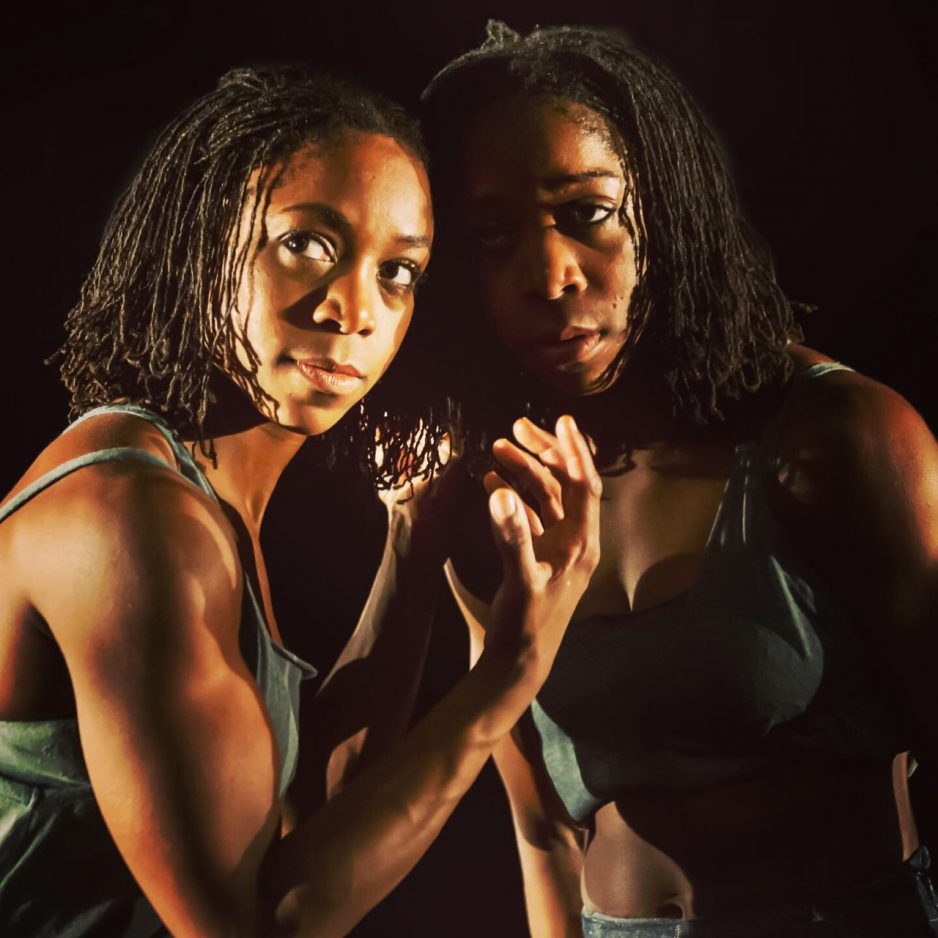
Image: Lidia Crisafulli
Home | Blog | Alleyne Dance – A Night’s Game
Alleyne Dance – A Night’s Game
It was fitting that the opening night of Alleyne Dance’s A Night’s Game featured a short presentation from the participants of a week-long workshop led by twin sisters Kristina and Sadé Alleyne. Titled Mobilise, this curtain raiser supplied us with important clues to the evening’s main event.
As I witnessed seamless transitions into and out of the floor and deep pliés in second position, my mind (and body) shifted back to two specific workshops I had signed up for in the past. Both were conducted by choreographers the Alleyne sisters have worked with. One, a workshop with Akram Kahn and one with Eduardo Torroja, who was representing Wim Vandekeybus’ Ultima Vez dance company in Dublin as part of the 25th Anniversary remount and subsequent tour of the company’s seminal work What The Body Does Not Remember.
Let me tell you, my body certainly does remember both workshops and if I delve too deeply it still smarts from the initial physical onslaught and painful aftermath. Yes, painful.
The Akram Kahn workshop’s duration was three hours. Akram was in Melbourne touring his solo, DESH, which translates as homeland in Bengali.
I was expecting the workshop to draw heavily on Akram’s formative Kathak dance training, which features both complex rhythmic structuring and numerous fast turns. I prepared myself for the drunken, unfocussed and unsteady balance, which inevitably ensues after too many revolutions, by eating very little in preparation.
Big mistake, as two of those three hours were solely spent moving in and out of that dreaded deep second, into an equally dreaded thigh-splitting deep lunge. No word of a lie. Akram decided to teach a big chunk of choreography from Gnosis, which featured a special guest in Japananese kodo drummer Yoshie Sunahata. In this particular sequence we had to emulate the beating of a large drum which stood on its side (hence the side lunge). I recall the warm up consisted of circling the wrists and progressively bending the knees and body, until we could achieve the desired height (or low). Inevitably our legs would start to unfurl until Kahn taunted us back down into submission. I remember having visions of my arms flying from my body, like rogue helicopter blades, they were waving so vigorously.
Fast forward two years and I am taking every workshop on offer whilst on a whirlwind trip to Dublin for their annual dance festival. This time it’s the Ultima Vez workshop in lead up to watching What The Body Does Not Remember.
I had participated in a workshop with Gavin Webber, the then AD of Dance North (and now The Farm) as part of the world Dance Alliance in Brisbane in 2008 and had assumed, because Webber had danced with Ultima Vez, that I was sufficiently prepared. But no, at the ripe age of forty-six I was the oldest participant paired up with the youngest at seventeen. He (my fledgling dance partner) had completed three dance classes in TOTAL and I was expected to take a run up and jump onto his shoulders while facing each other, before he hinged into the floor. He was game and I was terrified. I was also determined to get my money’s worth, so I demanded a spotter and went for it.
Again, my efforts were rewarded with a pain that severely hindered my ability to walk down stairs, tie my shoe laces and lift anything above my shoulders for the next two days.
It’s safe to state that I can imagine the physical fallout associated with the Alleyne extreme body experience.
Fast forward to the Alleyne sisters’ performance. To make those leaps onto chairs, into the air and onto each other look so effortless is no mean feat. To remember and play those complex rhythms on the body, alternately slapping the flesh with open palms, sliding the hands across linear expanses of skin, digging the heels into floor and clicking the fingers so deftly, deserved the standing ovation we didn’t give them that night. Maybe because the show felt a little too long with the generous preamble by the workshop performers, we could argue we were too exhausted to get to our feet. Maybe because there were a few false endings, which could have served as real ones, we refused to take a stand.
I suspect we didn’t rouse ourselves because after a while we become too complacent, saturated almost by the sheer physical virtuosity, which only ceased as the lights finally dimmed. I should’ve known better because the neurons are still pinging all over my body in empathy.
Highlights within the collage of movement dynamics meditating on the theme of incarceration include an extended solo of body twitches, the brief interludes of unison work and a repetitive kick-spring sequence taking the body from the back to a standing position to return to the floor. Salvatore Scollo’s uncluttered lighting states balanced out the busyness of the action on the tarkett. Dramaturgy was addressed by creating physical confines with pockets of light and was heightened in the last state by lowering the height of the stage with a sharp horizontal amber beam, set a metre above the dancers’ heads.
Brava Kristina and Sadé.

